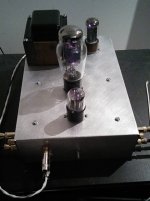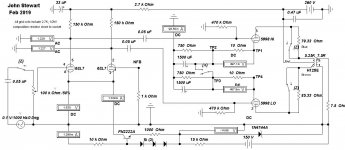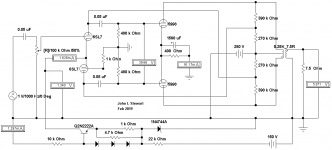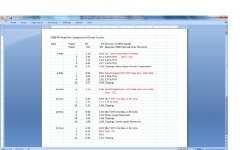The 01a capable to swing 40Vpp at 2V RMS input (active load, 300V B+) with -about- 0.4% THD.
Isn’t the total gain too low?
http://www.tubebooks.org/tubedata/5998_TS.PDF
I haven’t looked at the 5998 since I finished that amp a while back. I had originally built it with a 6SL7 as the driver as is the case for the FI 421A, but switched over to a 6922 or 6DJ8 with the Bottlehead C4S on the plates. From memory, the 5998 tube in that amp had a -48 volt bias on each triode. With the original 6SL7 as built it needed about 1.25 volts peak to peak or just under a volt RMS input to drive it fully. By my quick calculations an 01A with its amplification factor of 8 would require just over 5 volt p-p or 3.7 volts RMS. I’m not sure about the 01A or 30 with respect to the Miller capacitance of the 5998. I can say that when I switched over to a 6DJ8 with a CCS on the plate for the 5998 amp it did seem to sound more lively.
If you increase the bias voltage (decrease the anode current) the #30 will be even more unusable in this situation.
Even at 5-6V RMS capable able to accomplish this grid swing.
The "best scenario" is fix biased 10Y SE (at this B+, only A1), but in this case the A1 border at 3V RMS input.
A genuine 10Y is a very rare & valuable tube. Why not just use a 10?🙂
I forgot to mention el12n will be a suitable candidate at the output, it is indirect heating though.
Regards
Regards
EL12N specifications look very ordinary. What benefits does this tube confer to an audio circuit? And what about replacement, are they readily available? And the very odd socket required?🙂
I can't say that I've heard any serious degradation when I've used electrolytics either. I've heard differences in some cases and I do try to avoid them when practical.Canon is that capacitors are bad, and electrolytics are especially bad in tube amps. I generally try to avoid electrolytics as well and have a few amps that only use them on cathode resistor bypass because of the physical size required. That said, this amp sounds fantastic. It has been a bit of a revelation actually. It has a holographic quality that is unlike anything else I have built. I am using Elna Silmic II capacitors on the 30s.
I added a small film cap at the input as I had removed it during trouble shooting, but it changed something for the worse. It lost something with the input caps so I removed them. Imagination? Maybe...
A cap at the input will form a high pass filter when combined with the following grid leak resistor. The smaller the value, the higher the frequency. This may not affect the sound when you use it with the active crossover (which is doing the same thing, in effect) to power your horns but if you listen to it full range you should use a higher value cap so you don't roll off the bottom too much. If you're using small / cheap OTs, their abilities will also factor into the process of determining the best value to use.
I didn't notice the same issue when I tried the 30s but, as I said, there are too many differences in the setups to make any valid predictions about the sound of different tube types.All my everyday speakers have a horn for the highs. Generally, a hot mid or treble is problematic with these speakers. With the thirty, there does seem to be a mild treble emphasis as compared to my other amps, but it isn’t grating, shrieky or annoying.
Just curious, the data for the 5998 doesn't have anything related to it's use as an output tube. I assume you're using it SE with the two sections in parallel. How much power does it produce?http://www.tubebooks.org/tubedata/5998_TS.PDF
I haven’t looked at the 5998 since I finished that amp a while back.
Unless it's a lot, I would probably look at other alternatives considering that it takes 2.4A to heat each tube. If you need more power than a single 6V6 or 6BQ5 (or the 4.5w 6N6G that I'm using) will provide, another easy to drive output tube is the 7591 / 7868.
A genuine 10Y is a very rare & valuable tube. Why not just use a 10?🙂
10 is more rare, than popular 10Y (VT25).
Read my #56 post here https://www.diyaudio.com/forums/tub...iated-tungsten-output-tube-6.html#post6609988.
BTW in my daily used preamp the tubes are Radiotron ceramic base, graphite anode 801s from the thirties . 🙂
vinylsavor.blogspot.com/2014/04/tube-of-month-801a.html
I can't say that I've heard any serious degradation when I've used electrolytics either. I've heard differences in some cases and I do try to avoid them when practical.
A cap at the input will form a high pass filter when combined with the following grid leak resistor. The smaller the value, the higher the frequency. This may not affect the sound when you use it with the active crossover (which is doing the same thing, in effect) to power your horns but if you listen to it full range you should use a higher value cap so you don't roll off the bottom too much. If you're using small / cheap OTs, their abilities will also factor into the process of determining the best value to use.
I didn't notice the same issue when I tried the 30s but, as I said, there are too many differences in the setups to make any valid predictions about the sound of different tube types.
Just curious, the data for the 5998 doesn't have anything related to it's use as an output tube. I assume you're using it SE with the two sections in parallel. How much power does it produce?
Unless it's a lot, I would probably look at other alternatives considering that it takes 2.4A to heat each tube. If you need more power than a single 6V6 or 6BQ5 (or the 4.5w 6N6G that I'm using) will provide, another easy to drive output tube is the 7591 / 7868.
The 5998 is (arguably) identical to the WE 421A. My motivation for building the amp was this review of the FI 421A amp...
6moons audio reviews: Fi 421A stereo amp
I used the 5998 the same way that Don Garber used it in the 421A amp. One tube with one triode used per channel and a 6SL7 driver tube. With my operating point of 256 volts plate to cathode and -46.5 volt bias, or around 12 watts dissipation, I was getting just under 4 watts a channel. Have a look at the thread where I was trying to get help for its build...
5998/421A build and schematic feedback wanted
Since the last post on that thread, I switched the 6SL7 for a 6922 with a Bottlehead C4S CCS plate load, and now use a 5R4WGB “potato masher” rectifier to drop the voltage a bit. I think it sounds more lively with the 6922 and CCS. It’s also cool because it is a stereo amp with three tubes. If it had a solid state rectifier, it could be a 2 tube stereo amp. I’ll attach a photo of it...
Attachments
EL12N specifications look very ordinary. What benefits does this tube confer to an audio circuit? And what about replacement, are they readily available? And the very odd socket required?🙂
I've used the EL12n in triode and it's a good sounding tube with Ri around 1K and mu=17 approx. So you can drive this with a 10Y which I've done and it sounds very nice. It's a fairly cheap and available German tube, e.g. from BTB in Germany. Good for at least 18W dissipation. Sockets are a common European type for older tubes, and work nicely. Maybe my favourite socket type. I call this kind of amp an "Inverse DHT Amp". Unlike the usual 300b/45 amps, the DHT is the driver and the output tube is indirectly heated. Certainly a viable option, though there aren't many output tubes with mu of 17 or more. EL84 in triode is one, for example. For lower power there's also EL33 and EL11 in triode. Both very nice and a little better sounding than EL84 in triode. I went through all these options last year in lockdown. Being a European I like the European tradition of tubes and sockets, which you don't see much of over in the USA.
.
Last edited:
andyjevans: There appears to be a difference in availability of tube types between Europe and North America. The EL12N is not a tube I have ever come across, and I have bought multiple large lots of random tubes over the years.
I don’t have a IDHT to DHT tube amp in my stable. I plan to build the Loesch Legacy amp soon, and have the bits for a 45 and a 46 amp. The scarcity of selection of available tube combinations for an Inverse DHT amp is mirrored by the scarcity of single tubes/stages that can properly drive a 45 or 300B. It’s a worse situation for the Inverse DHT amp. That said, the EL84 is a great sounding tube that is doing the job very well in my Inverse DHT. Even better in my setup is the 6P15P-EV, which sounds better than any EL84 type I have tried so far. Unfortunately, there are not a lot of reasonably priced or available North American choices for a power tube in an Inverse DHT.
I have always thought that much of the flavour of an amp came from the pre rather than the power stage. Poorly driven DHTs are also thick on the ground in DIY and commercial amps. I need an easy to drive big bottle that will be happy with a 30, 26 or 01A driving it. That or a three stage amp with a less easy to drive one. I’m avoiding that for now though...
This takes me back to an earlier unanswered question. How much of, for example, a 01A preamp’s aural signature comes through when combined with a class A solid state amp or just any amp in general? By the way, you were absolutely correct about the 30 being better than any IDHT pre tube.
I don’t have a IDHT to DHT tube amp in my stable. I plan to build the Loesch Legacy amp soon, and have the bits for a 45 and a 46 amp. The scarcity of selection of available tube combinations for an Inverse DHT amp is mirrored by the scarcity of single tubes/stages that can properly drive a 45 or 300B. It’s a worse situation for the Inverse DHT amp. That said, the EL84 is a great sounding tube that is doing the job very well in my Inverse DHT. Even better in my setup is the 6P15P-EV, which sounds better than any EL84 type I have tried so far. Unfortunately, there are not a lot of reasonably priced or available North American choices for a power tube in an Inverse DHT.
I have always thought that much of the flavour of an amp came from the pre rather than the power stage. Poorly driven DHTs are also thick on the ground in DIY and commercial amps. I need an easy to drive big bottle that will be happy with a 30, 26 or 01A driving it. That or a three stage amp with a less easy to drive one. I’m avoiding that for now though...
This takes me back to an earlier unanswered question. How much of, for example, a 01A preamp’s aural signature comes through when combined with a class A solid state amp or just any amp in general? By the way, you were absolutely correct about the 30 being better than any IDHT pre tube.
Last edited:
'This takes me back to an earlier unanswered question. How much of, for example, a 01A preamp’s aural signature comes through when combined with a class A solid state amp or just any amp in general?'
How much will depend on system topology and simplicity. A full range speaker usually shows most of the changes. Since you have 10/10Y in your collection please go ahead and build it and find the outcome for yourself. Please remember each of us has unique
experiences.
By the way, you were absolutely correct about the 30 being better than any IDHT pre tube.'
You are right. In fact people who are dealing with DHT know already that most any DHT sound better than IDHT signal tube (and power tube, if that matter).
Regards
How much will depend on system topology and simplicity. A full range speaker usually shows most of the changes. Since you have 10/10Y in your collection please go ahead and build it and find the outcome for yourself. Please remember each of us has unique
experiences.
By the way, you were absolutely correct about the 30 being better than any IDHT pre tube.'
You are right. In fact people who are dealing with DHT know already that most any DHT sound better than IDHT signal tube (and power tube, if that matter).
Regards
That's a cool looking amp. The 5998 looks interesting, I'll have to take a closer look. But that's an awful lot of heater current for less than 4w output. Of course, it's colder where you live, so maybe that's a positive characteristic for you. 😀 What's the distortion level at 4w?I used the 5998 the same way that Don Garber used it in the 421A amp. One tube with one triode used per channel and a 6SL7 driver tube. With my operating point of 256 volts plate to cathode and -46.5 volt bias, or around 12 watts dissipation, I was getting just under 4 watts a channel.
I guess that's the whole premise of this thread and I'm certainly finding it to be true with my breadboarded 26 - 6N6G SET.I have always thought that much of the flavour of an amp came from the pre rather than the power stage.
As for easy to drive tubes, the 6V6, EL84 and 6N6G are all easy to drive and produce similar levels of power output as long as you run the 6V6 and EL84 in pentode. And, depending on your taste, pentode may require negative feedback of some type. If you insist on a triode output, the 6N6G has about twice the power.The scarcity of selection of available tube combinations for an Inverse DHT amp is mirrored by the scarcity of single tubes/stages that can properly drive a 45 or 300B. It’s a worse situation for the Inverse DHT amp. . . . Unfortunately, there are not a lot of reasonably priced or available North American choices for a power tube in an Inverse DHT. . . . I need an easy to drive big bottle that will be happy with a 30, 26 or 01A driving it.
Another difference is that, while the power levels are about the same, the distortion levels are not. Distortion is 10% for the EL84, 8% to 12% for the 6V6 but only 5% for the 6N6G. The data sheet notes that the 6N6G will produce a bit more power than the others (6.5w) at 10% distortion.
Sticking with easy to drive tubes, the next step up in power seems to be the 7591 / 7868 which will put out 11w but, again, that's in pentode. And that's at 13% distortion, so it's unclear how much power it will provide at a lower level of distortion.
What other single tubes can be driven as easily as these? I assume there must be at least a few.
FlaCharlie: jhstewart measured the distortion of the 5998 amp in its current form and gave me a printout, but I won’t be able to get to it until next week. He tried a few different drivers with the 5998 in push pull as well. It has two triodes, so each tube does a channel. From memory, I recall 10 watts in PP. It is a pricey tube though.
I’ll check out the 6N6G. I don’t have any in inventory but will pick up a few to play around with.
The 7591 has a “triode amplification factor” of 16.8, which is pretty close to the EL84’s 19, and much more than a 6V6 at 9.8. The The 7869 is internally identical to the 7591. I have a 3 or 4 7968s in inventory and another 6 installed in old amps I purchased long ago. That may be my next power tube to use with a DHT driver. It’s nice that they are also available new. I also happen to have 2 tube sockets to use with them. Thanks for the heads up!
The 6V6 data sheet has numbers for triode connected operation.
https://shop.ehx.com/catalog/addimages/7591.pdf
http://on-air.ru/tubes/6V6GT-GE.pdf
An amp like the 30/EL84 one I built could be put in front of a 300B with some mods, or in front of a large triode connected pentode like a KT120 for 8 watts or so. That could sound good too. Three stages though.
I’ll check out the 6N6G. I don’t have any in inventory but will pick up a few to play around with.
The 7591 has a “triode amplification factor” of 16.8, which is pretty close to the EL84’s 19, and much more than a 6V6 at 9.8. The The 7869 is internally identical to the 7591. I have a 3 or 4 7968s in inventory and another 6 installed in old amps I purchased long ago. That may be my next power tube to use with a DHT driver. It’s nice that they are also available new. I also happen to have 2 tube sockets to use with them. Thanks for the heads up!
The 6V6 data sheet has numbers for triode connected operation.
https://shop.ehx.com/catalog/addimages/7591.pdf
http://on-air.ru/tubes/6V6GT-GE.pdf
An amp like the 30/EL84 one I built could be put in front of a 300B with some mods, or in front of a large triode connected pentode like a KT120 for 8 watts or so. That could sound good too. Three stages though.
I thought your 5998 amp was SE using a single tube, one triode section per channel. Or are we talking about two different amps?FlaCharlie: jhstewart measured the distortion of the 5998 amp in its current form and gave me a printout, but I won’t be able to get to it until next week. He tried a few different drivers with the 5998 in push pull as well. It has two triodes, so each tube does a channel. From memory, I recall 10 watts in PP. It is a pricey tube though.
I’ll check out the 6N6G. I don’t have any in inventory but will pick up a few to play around with.
The 6N6G will also do ~10 watts in PP. I modded a Magnavox PP 6V6 amp to use them, which is really simple of course. Used all the stock transformers with a 5751 front end copied from a $3500 Leben EL84 integrated.
Here's a thread about it if you're interested. It's ugly but it sounds great.
Magnavox 175/185 Build . . . With a Twist | Audiokarma Home Audio Stereo Discussion Forums
I've also seen Andy Evans comment on the mu of various output tubes. I've never concerned myself with a tube's mu unless I'm planning on using it as a preamp tube. When I'm looking at output tubes, I always just look at the power output listed in the data sheet.The 7591 has a “triode amplification factor” of 16.8, which is pretty close to the EL84’s 19, and much more than a 6V6 at 9.8. . . . That may be my next power tube to use with a DHT driver. It’s nice that they are also available new. I also happen to have 2 tube sockets to use with them. Thanks for the heads up!
What, if anything, does the mu tell you about a tube's suitability as an output tube that is not revealed by the power output?
I've never considered using the 300B simply because they're so expensive, and if you're into tube rolling we're talking about a serious rabbit hole. I don't really know anything about the KT120 but they're probably not cheap either, I'm guessing.An amp like the 30/EL84 one I built could be put in front of a 300B with some mods, or in front of a large triode connected pentode like a KT120 for 8 watts or so. That could sound good too. Three stages though.
Perhaps someone will recommend some other outputs that are easy to drive and not expensive.
Another option might be to use an output that's more difficult to drive with a higher mu DHP as input??
My amp is SE. I gave jhstewart a 5998 to experiment with and he tried it as a single tube in PP. In PP the tube uses 2.4 amps for heating the two triodes, which is high but, at 1.2 amps per triode, not crazy high.I thought your 5998 amp was SE using a single tube, one triode section per channel. Or are we talking about two different amps?
What, if anything, does the mu tell you about a tube's suitability as an output tube that is not revealed by the power output?
With a two stage amp, and the standard source output of 2 volts, the amplification factor tells me if a combination of driver and power tube will have enough gain to fully drive the power tube with a 2 volt input. Is my understanding of this incorrect?
5998 PP Amp
Some Results using Hammond 125E Universal OPT.🙂
Damping Factor is 2.64
For 10 Watts Output 1.6 vrms is required at the input
Intermodulation Distortion Measurements (IMD) are made by two methods-
Two Equal Level Frequencies, One & 1.6 KHz
80 Hz signal 12 db greater than 5 KHz, Sidebands of 5 KHz measured
Clipping begins at about 10 Watts
-3db at One Watt, 24 Hz & 16 KHz
https://subscribe.theweek.com/servl...cds_page_id=249509&cds_response_key=I0DRPKRW3
Some Results using Hammond 125E Universal OPT.🙂
Damping Factor is 2.64
For 10 Watts Output 1.6 vrms is required at the input
Intermodulation Distortion Measurements (IMD) are made by two methods-
Two Equal Level Frequencies, One & 1.6 KHz
80 Hz signal 12 db greater than 5 KHz, Sidebands of 5 KHz measured
Clipping begins at about 10 Watts
-3db at One Watt, 24 Hz & 16 KHz
https://subscribe.theweek.com/servl...cds_page_id=249509&cds_response_key=I0DRPKRW3
Attachments
-
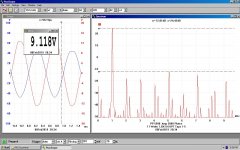 PP 5998 Amp 11 Watts OPT Taps 1-5.JPG133.5 KB · Views: 74
PP 5998 Amp 11 Watts OPT Taps 1-5.JPG133.5 KB · Views: 74 -
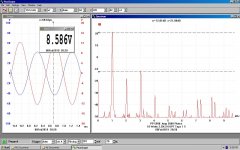 PP 5998 Amp 10 Watts OPT Taps 1-5.JPG131.1 KB · Views: 64
PP 5998 Amp 10 Watts OPT Taps 1-5.JPG131.1 KB · Views: 64 -
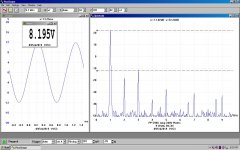 PP 5998 Amp 9 Watts.JPG125.6 KB · Views: 70
PP 5998 Amp 9 Watts.JPG125.6 KB · Views: 70 -
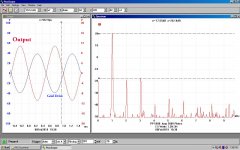 PP 5998 Amp 7.5 Watts w Captions.jpg241.3 KB · Views: 174
PP 5998 Amp 7.5 Watts w Captions.jpg241.3 KB · Views: 174 -
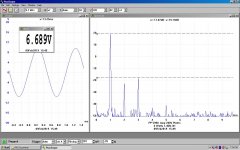 PP 5998 Amp 6W 1.46% 3H.JPG121.6 KB · Views: 169
PP 5998 Amp 6W 1.46% 3H.JPG121.6 KB · Views: 169 -
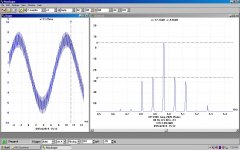 PP 5998 Amp 3 Watt IMD 80 Hz & 5 KHz.JPG130.1 KB · Views: 157
PP 5998 Amp 3 Watt IMD 80 Hz & 5 KHz.JPG130.1 KB · Views: 157 -
 PP 5998 Amp 2 Watts Equal One & 1.6 KHz.JPG123.3 KB · Views: 183
PP 5998 Amp 2 Watts Equal One & 1.6 KHz.JPG123.3 KB · Views: 183 -
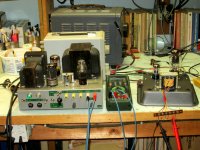 IMG_3997 Betty Crocker 5998 Ampon the Bench.jpg533.7 KB · Views: 192
IMG_3997 Betty Crocker 5998 Ampon the Bench.jpg533.7 KB · Views: 192
''With a two stage amp, and the standard source output of 2 volts, the amplification factor tells me if a combination of driver and power tube will have enough gain to fully drive the power tube with a 2 volt input. Is my understanding of this incorrect?''
Yes correct. You also need to factor in opt turn ratio. The same is true for three stage amp or whatever.
''What, if anything, does the mu tell you about a tube's suitability as an output tube that is not revealed by the power output?''
Higher mu tube's grid sits at lower negative voltage so it needs less voltage drive from the driver tube and vice versa.
THE ABOVE IS NEEDED TO DESIGN YOUR AMP. ONCE YOU LEARN IT YOU DON'T NEED ANY SCHEMATIC. IN ADDITION YOU LEARN DESIGNING PS AND YOU ARE A FREE SOUL.
Regards
Regards
Yes correct. You also need to factor in opt turn ratio. The same is true for three stage amp or whatever.
''What, if anything, does the mu tell you about a tube's suitability as an output tube that is not revealed by the power output?''
Higher mu tube's grid sits at lower negative voltage so it needs less voltage drive from the driver tube and vice versa.
THE ABOVE IS NEEDED TO DESIGN YOUR AMP. ONCE YOU LEARN IT YOU DON'T NEED ANY SCHEMATIC. IN ADDITION YOU LEARN DESIGNING PS AND YOU ARE A FREE SOUL.
Regards
Regards
More 5998 Test Data
I tried many different combinations of driver & 5998 biasing.
And other sets of date covering PP 6BX7s (3W), PP 6BL7 (3W) & PP 6SN7 (one Watt). Much of the results are here in DIY on Lings thread covering his flea power 6SN7 project. The 6BL7 or 6BX7 can be used in his project with the proper OPT.🙂
I tried many different combinations of driver & 5998 biasing.
And other sets of date covering PP 6BX7s (3W), PP 6BL7 (3W) & PP 6SN7 (one Watt). Much of the results are here in DIY on Lings thread covering his flea power 6SN7 project. The 6BL7 or 6BX7 can be used in his project with the proper OPT.🙂
Attachments
Thanks for the explanation. But I'm still confused.''With a two stage amp, and the standard source output of 2 volts, the amplification factor tells me if a combination of driver and power tube will have enough gain to fully drive the power tube with a 2 volt input. Is my understanding of this incorrect?''
Yes correct. You also need to factor in opt turn ratio. The same is true for three stage amp or whatever.
''What, if anything, does the mu tell you about a tube's suitability as an output tube that is not revealed by the power output?''
Higher mu tube's grid sits at lower negative voltage so it needs less voltage drive from the driver tube and vice versa.
THE ABOVE IS NEEDED TO DESIGN YOUR AMP. ONCE YOU LEARN IT YOU DON'T NEED ANY SCHEMATIC. IN ADDITION YOU LEARN DESIGNING PS AND YOU ARE A FREE SOUL.
I always assumed that the nominal 2v from the source was simply multiplied by the mu of the input tube and that the result was the voltage available to drive the output tube. Once that signal goes through the output tube the result is the power output listed in the output tube's data sheet.
If the mu of the output tube is a factor in determining the amount of signal needed to drive it, why isn't it (the output tube's mu) listed in the data?
When looking at data sheets for commonly used output tubes - 6V6 and 6BQ5 for instance since that's what tizman has been using - there don't seem to be any figures for mu listed at all.
And while the data sheets list the rated power output, they don't typically specify the level of input signal needed to produce the rated power output. They list all the other operating conditions, but not the actual input signal voltage. Although, again, the data sheet for the 6N6G is an exception in that it specifies a 15v input.
Oddly, output tube data sheets typically do list the plate and screen current at zero signal and maximum signal input, but they never actually specify what the maximum signal voltage is. Is there a reason for this apparent omission?
I am aware of the general relationship between grid voltage and input signal strength - that the more negative the specified grid voltage is, the more signal is needed to drive the output tube to full power. But that's pretty vague. Why don't they just specify a particular level of input signal?
I assume there's something I'm missing in trying to understand this. Your expertise and patience are appreciated!
- Home
- Amplifiers
- Tubes / Valves
- DHT driver for triode wired SE EL84, 6V6 or EL34
